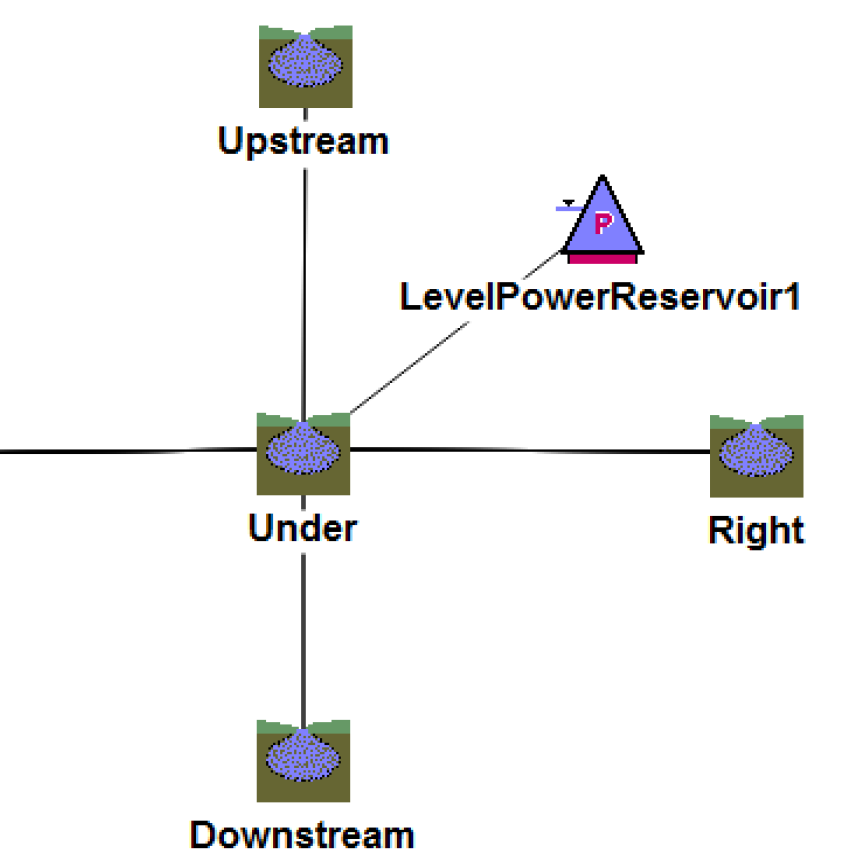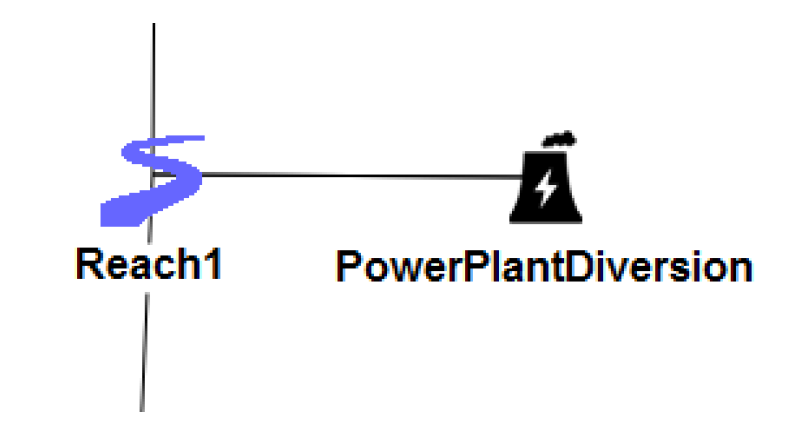Objects
Distribution Canal: Request Routing
The Distribution Canal now allows a monthly model to propagate requests if the lag is set to zero.
Groundwater
Linking to a Reservoir
A new solution type was added to model the interaction between a Reservoir and the groundwater beneath the reservoir. This “under reservoir” Groundwater object propagates the elevation and flows, but does not track storage. On the Groundwater object, select the new Head Based Boundary Condition method in the Solution Type category. Then link previous elevations and flow slots. The Groundwater object can then be linked to other Groundwater objects that use the Head Based Groundwater Grid method in the Solution Type category.

More information can be found Head Based Boundary Condition in Objects and Methods.
Preventing Negative Storage
For Groundwater objects with a Solution Type of Head Based Groundwater Grid, the calculation of Storage was revised to prevent negative values. The calculation of Percolation, Evaporation and Evapotranspiration are now limited so that they will not cause Storage to be negative. Additionally, a new set of slots called Flow Factor Upstream/Downstream/Left/Right can optionally be linked to the corresponding Flow Factor slot on adjacent Groundwater objects. The Flow Factor slots, when linked, compute and limit the lateral flows from one Groundwater object to another when Storage is close to zero.
The new application of Percolation, Evaporation and Evapotranspiration are always applied and thus, could result in model differences for models that previously produced negative Groundwater Storage values.
Details about how Storage is calculated on Groundwater objects with the Head Based Groundwater Grid solution can be found Solve given Inflow from Surface Water in Objects and Methods.
Specified Inflows
The Groundwater object was enhanced to allow a Specified Inflow. This ungaged flow can be used to add or remove a series of inflows (can be specified as periodic data) to the Groundwater object. More information is available Head Based Groundwater Grid in Objects and Methods.
In addition, water quality salinity slots were added to model the addition or subtraction of salt via these flows. Documentation is available Specified Inflow Slots in Water Quality.
Inline Power
Pre-simulation Dispatching
The Inline Power Plant is now able to dispatch before the start of the run. As a result, if your model has pre-simulation inputs, you may need to clear those out to prevent an over determination error.
In addition, the computational subbasin Initialize flow slots for Routing was changed to now look downstream through the Inline Power object. Previously, it stopped at this object. Finally, the Outflow slot is no longer backcasted, but the Inflow slot will be backcasted if it is not linked.
Specify Units Generating: Unit Turbine Release is Now Included
When the Specify Units Generating method was originally implemented for RiverWare 7.1, it only included Generation Capacity; the Power calculation was independent of Turbine Release. Now Unit Turbine Capacity has been added to the Unit Capacity slot, and you can optionally input the Unit Turbine Capacity. Also a new Unit Turbine Release slot was added which can be optionally input. If you do not input Unit Turbine Release, it is calculated by the method by multiplying the Unit Turbine Capacity by the Unit Generation Fraction. The method also now sets the total plant Turbine Release.
As part of this enhancement, the Unit Capacity table slot was converted from a 1xN slot with one column for each unit's generation capacity to a Nx2 table with a row for each unit. The first column is now Unit Turbine Capacity (flow), and the second column is now Unit Generation Capacity (power). If this method was previously implemented in a model using RiverWare 7.1, it will be necessary to repopulate the Unit Capacity slot with data the first time the model is loaded in the new version of RiverWare.
See Specify Units Generating in Objects and Methods for more information.
Power Plant Diversion and Generator Object
A new aggregate object was added: the Power Plant Diversion, and its Generator elements. Often these are used to model the diversions and depletions required for power plant cooling. This object will divert from a reach, reservoir or aggregate distribution canal to meet the requests. Diversion and depletion requests are computed by one or more linked Generator element objects. User selectable methods compute the required diversion and depletion based on generator characteristics. More information on the Power Plant Diversion can be found Power Plant Diversion in Objects and Methods while information on the Generator can be found Objects and Methods in Objects and Methods.

Reservoirs
Linking to Groundwater
A new solution type was added to model the interaction between a Reservoir and the groundwater beneath the reservoir. This “under reservoir” groundwater object propagates the elevation and flows, but does not track storage.
More information on the new Linked Seepage method and linking to a Groundwater object can be found Linking to a Reservoir.
Diversion Power
New categories were added to the reservoirs that enable you to model power produced through the Diversion slot. Three new categories were added to the Reservoirs. Each has a default method of None and one new non-default method:
• Diversion Power: Diversion Power Efficiency Curve
• Diversion Tailwater: Diversion Base Value Plus Lookup
• Diversion Power Bypass: Diversion Power Bypass Capacity Table
See Level Power Reservoir in Objects and Methods for more information.
Max Iterations - Default Value
The Max Iterations slot on a Reservoir previously had a default value of 20. It is common for iterative solutions to require more than 20 iterations, so the value has been increased to 100. This will not affect existing models. It will only affect new Reservoir objects. Corresponding warning messages were also adjusted. Previously a warning was issued if the slot value was greater than 100. Now the warning is only issued if the slot value is greater than 1000.
Water User
Dispatch Slots
On the Water User, the Return Flow Salt Mass was added as a linkable dispatch slot. This slot should be linked for certain salinity modeling approaches, described Salinity in Water Quality.
Removal of Unused Optimization Categories
The unused Optimization WU Request Category and the Aggregate Optimization Requests category were removed from the Water User and from the Agg Diversion Site, respectively. Warning messages are posted when a model is first loaded in 7.2.
Revised: 07/17/2020